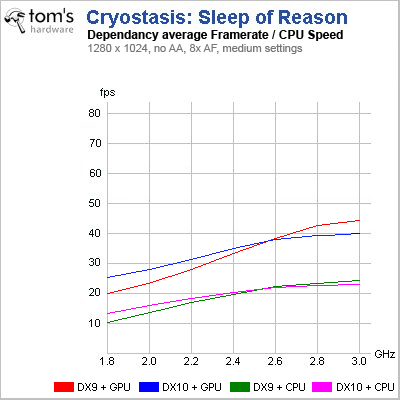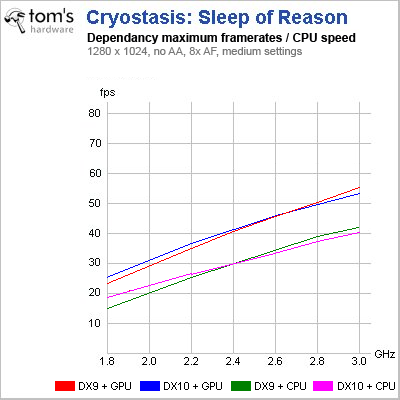Cryostasis: From Russia, With An Appetite For Fast Hardware
Hardware Test: Mid-Range PCs
Now let’s turn to a typical mid-range PC. Here, we use a (simulated) Intel Core Duo with clock rates ranging from 1.8 GHz to 3.0 GHz. This encompasses a range of processors from the dual-core E2000 all the way through the E6850. Likewise, the Core Duo Series E8000, E7000, and E5000 also produce similar results at similar clock rates, so that we can summarize results from a huge number of target CPUs with our tests. In addition, we don’t expect the smaller caches in lower-end models to make much difference, nor to see much impact from the differences between 65 and 45 nm processes.
AMD CPUs also scale similarly at increasing clock rates. The AMD model we tested in the previous round at 2.6 GHz matches up in the middle of this range, somewhere between the 1.8 GHz and 2.0 GHz Intel dual-core models. Our heavily-overclocked graphics card falls somewhere between a Radeon HD 4850 and a Radeon HD 4870, and is generally in the same performance league as a GeForce 9800 GTX+. This is pretty close to an average gaming PC nowadays (as represented here in the Gaming PC 1 configuration). We also tested on Vista in this case, so we could compare DirectX 9 and DirectX 10 results.
Test 1: Average Frame Rates for DirectX 9 vs. DirectX 10 and GPU vs. CPU PhysX
Average frame rates were our next area of interest, along with outliers on the low side because these represent frame-rate hiccups that are most likely to interfere with game play. Once again, we present cumulative values for our three game scenes and animated sequences and produce some interesting results. Overall, graphics settings were upped to middle values, because we couldn’t really play the games when settings were increased any further than that.

We found it very interesting that when running Shader Model 4.0 under DirectX 10 at lower clock rates (that is, on less powerful CPUs), we observed higher frame rates than we did with DirectX 9. At 2.6 GHZ, both sets of values were nearly identical, whereas DirectX 9 appeared to benefit more from higher clock rates than did DirectX 10. At first, we were inclined to question these results, but further testing with other scenes only confirmed our initial findings.
The obvious difference between GPU-assisted PhysX versus CPU calculations isn’t as noticeable in game play as it is on the graph, because fast-motion sequences usually occur at higher frame rates. After a while during game play, one learns to sense which scenes are most likely to act like speed bumps.
Test 2: Maximum Frame Rates: DirectX 9 vs. DirectX 10, and GPU vs. CPU PhysX
Stay On the Cutting Edge: Get the Tom's Hardware Newsletter
Get Tom's Hardware's best news and in-depth reviews, straight to your inbox.
Next, we evaluate maximum frame rates. Here, the measured values corresponded perfectly to our subjective impressions.

The same picture is painted here: weaker CPUs benefit most from DirectX 10 as compared to more powerful ones with higher clock rates. These results either demonstrate the benefits of offloading physics calculations onto the GPU or indicate that the differences really aren’t as great. The resolution chosen also plays a role when it comes to frame rates, but we never found a situation where scenes that were fluid and smooth in 1280x1024 became unplayable at 1680x1050. Frame rates only decrease somewhat, so that you can play reasonably fluidly on a 20” to 22” monitor.
ATI cards lack PhysX hardware support, so they don’t do quite as well in their overall evaluations. We tested a Radeon HD 4870 with 1 GB of graphics RAM, using CPU physics calculations and Shader Model 3.0, and it performed nearly the same as the Nvidia card. Also, it did not slow down with AA enabled. The Radeon HD 4870 wasn’t exactly trouble-free though, and required a small trick to fix—more on this later.
Playability
With an Intel dual-core processor at 2.4 GHz or higher or an Athlon 64 X2 at 2.8 GHz or higher, and a mid-range $100 graphic card or better, Cryostasis offers fluid, pleasing play as long as you don’t boost the graphics settings too high. Here, the advantage goes to the Nvidia cards, given higher frame rates that make the game more fluid and visually pleasing. We saw no big differences between turning GPU-assisted PhysX on or off during our tests. The shipping game is quite different in this respect compared to the demo.
Visuals
As is usually the case at minimum settings, mid-range graphics settings similarly fail to impress us with graphical delights. Modest increases in hardware capability don’t do this game real justice. They can’t come close to doing what high-end systems can.
Current page: Hardware Test: Mid-Range PCs
Prev Page Hardware Test: Recommended System Configurations Next Page Hardware Test: Can A High-End PC Achieve A Performance Break-Through?-
truehighroller I heard this game was messy. I recently purchased Prototype though and it is a good game...Reply -
werr20 i played this game and it's nice ! i have x3 720be(2,8ghz),4gb ram ddr2, 4850 512mb .on my pc it runs smoothReply -
anamaniac Penttium D 2.8GHz, 1gb ddr2 533, ATi 4670 (underclocked to hell because of computer stability recently).Reply
I took the game all not too bad.
Looks and sounds amazing.
However, it couldn't really catch my attention long enough to develop an interest to delve even 30 minutes into the game. -
darkpower45 soooo when did toms start to do game reviews? just a thought. The game looks pretty good though. The good think about the review is that it showed the performance on the low end systems. Good review even if its a game not hardware.Reply -
curnel_D I'll be honest, I really didnt like the way the benchmark sections were done. Not because of poor information, but because of poor management of that information. At 3 in the morning, it's hard to figure out what's going on.Reply
On the flip side, I do like the game reviews lately. Perhaps we can see a resurection of Toms Games, and perhaps even the illustrious Second Take? :D -
You managed to benchmark with Nvidia cards exclusively, you keep reminding me why I almost never visit this site any more.Reply
-
Andraxxus If you have a good PC it might be an enjoyable experience but if you don't have one then stay away. I could not even run it but i've seen in on a good PC and it looks and sounds good.Reply -
falchard I would like to see a game developer say. Screw nVidia, they keep holding back progress and use their developers network as a method to retain a user base. I am going to make a game that completely takes advantage of ATI hardware. From multi-processing units, to tesselation and ray tracing.Reply -
Onus I think they mostly used nVidia because of PhysX, at least that was my take on it. They did use some ATI cards too.Reply
Although this is not my kind of game, the review was written in a manner that I thought gave good information on how it might run on my system.
I'd like to see Second Take return as well, even though I don't recall it addressing hardware requirements the way this review did.
-
marraco Is fantasy, not science fiction.Reply
I played the game entirely, and I don't recommend it until a much needed patch is available.
The game really gets no benefit from PhysX (I buyed the game hoping to play a game physx capable).
And the performance is really poor. I was forced to play it on 1024x768, without any antialiasing, on a Geforce 8800 GT oc, and still got lots of glitches, and bad framerates.
The sound frequently ruined itself completely, and sometimes crashed.
Sometimes you get stuck on places, and finds yourself incapable of progressing. Then reload an older saved game, and finds that you got stuck because of a bug, instead a by design game. Sometimes a tube bends too vertically, and you cannot escape a room, or fix it.
The savegame system is broken. Sometimes you save a game, but are unable to reload it, or reload it and after a looong reload time, just finds that the small screenshot and filename does not match what was showed, and you loaded another file.
Although the game introduces some welcomed original innovations (common First Person Shooters are getting really repetitive lately), all the bugs it have make playing it a really painful experience. I had good hardware, but my experience was poor, and was no exception. I found lots of people with the same problems on internet (although others had slower hardware than me, and got no problems).
I strongly recommend to wait for a patch to be released, before acquiring the game.
After it, I played FEAR 2. It was so much optimized software, and played so smoothly, even on max settings, that I really enjoyed it.